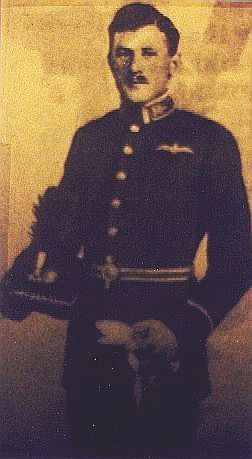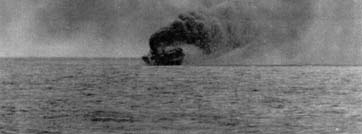

He was the son of a Royal Naval Lieutenant Commander who had lost his own life under eerily similar circumstances at the battle of Jutland during the Great War, and his widow, the late Winifred Ede, proprieter of the defunct Cloverleaf restaurant in the Walker Arcade, in Hamilton. Young Ede was raised by his mother in Pembroke, and entered the RAF in 1937, attending the RAF College at Cranwell. Posted to Fighter Command as a Gladiator pilot, he went first to 111 Squadron, but in the Spring of 1940 he was drafted to 263 Squadron, which was re-building in Scotland after its return from Norway. With its aircraft replaced and its personnel back up to strength, the squadron was immediately despatched back to Norway to resume their ill-fated defense of that country from its Nazi invaders (the pre-war Bermuda liner, the Monarch of Bermuda, incidentally, had delivered Scots and Irish guards to Narvik, Norway on the 14 April, 1940).
As on their second deployment, the squadron was delivered to Norway aboard a Royal Naval aircraft carrier. Their eighteen Gladiators were flown aboard HMS Furious by Fleet Air Arm Pilots. They would, in fact, borrow of some of that carriers Sea-Gladiator fighters, and take attachment of one of its naval pilots to make up loss of one of their own.. On this deployment, 263 Sqn. was accompanied by 46 Squadron with its Hurricane fighters. These high speed monoplanes were superior in performance and firepower to 263'sGladiator bi-planes, but had never been operated from a carrier before. Lacking arrestor gear, none of the RAF fighters was precisely safe to land, but with its higher landing speed this was more a problem for the Hurricane. It was not envisaged that these aircraft would be flown onto the ship, however-they were loaded by crane in port aboard the Glorious' sister-ship HMS Furious.With the carriers turned into the wind, the aircraft were flown off on their arrival off the Norwegian coast.
263 Squadron flew off the first two sections, each of two Gladiators, on the 21st May, with a Fleet Air Arm Swordfish as a guide. Due to rapidly deteriorating visibility, one flight turned back. Despite their lack of arrestor gear or training in carrier landings they actually landed successfully.. The other flight was not so lucky, all three aircraft crashing in the blinding conditions with the swordfish crew, and one of the Gladiator pilots being killed.
Eight of the Gladiators managed to reach Bardufoss the following day, becoming engaged in combat immediately. The remainder arrived a day later, on the 23rd.
On the morning of the 24th, four German Messerschmidt Bf110 twin engined fighters strafed the aircraft dispersed about the field. FO Ede took off to engage them. The Bf110 was a faster aircraft with a considerable advantage in firepower to the already obsolete Gladiator bi-plane, but was far less maneuverable and Grant Ede was able to pour fire on them before they out-ran him, causing one to crash onto a frozen lake near Thysfjord.
Later that day, in the company of another Gladiator, Grant Ede attacked a lone Heinkel He111 bomber. He machine-gunned the rear gunner, and his companion shot-out the starboard motor. Another Gladiator joined them and shot-out the port motor. The German pilot made a forced landing, and the three Gladiator pilots shared the kill.
At 09:00 the following morning, the 25th., Grant Ede flew his first sortie in Gladiator N5705 over Hardsta. He chanced upon a Focke-Wulf 200 making a reconnaisance at 15,000 feet and shot it down over Dryoy Island.
Flying a second patrol at 10:30, he came upon a Junkers Ju 90-another four engined aircraft, over Finnoen island and sent it down in flames.
This was to be Ede's last aerial victory, though the Squadron made many more, and did useful work strafing German ground units before the inevitable was acknowledged. The allied defenders could not prevent Germany's imminent victory in Norway and on the 7 June 263 and 46 Squadrons were ordered to rejoin HMS Glorious to be evacuated back to Britain. 263 Squadron had already demonstrated its pilots could land their arrestor gear bereft bi-planes on a carrier's deck, but no-one had ever attempted this with a high-speed fighter like the Hurricane and the prospects for success could not be estimated. Nontheless, 46 Squadron managed the feat and, with 263 Sqn., they turned for home aboard the Glorious. Despite having been forced to abandon Norway to her fate, the RAF deployment, and the allied defenders as a whole, could hold their heads high as they had, at a considerable disadvantage of men and material, made the invaders pay dearly for every inch.
The Glorious and its two guest squadrons hadn't payed their own cost fully, yet, though.
During the afternoon of the 8 June, as the Glorious and her escort were travelling southwest, about 360miles west of Narvik, they were ambushed by the German battlecruisers Scharnhorst, Gneisnau and Hipper. All the British vessels were sunk. Among the dead were all of the Royal Airforce and Fleet Air Arm aircrew, but six.
Flying Officer Ede's mother was first informed her son was missing. The magnitude of the disaster was not immediately appreciatted, however, and the RAF believed that many of their missing might have been picked up by the Germans. On 7 August he was still listed as missing when the announcement was made that he was to be awarded the Distinguished Flying Cross.(Confusingly,the brief statement from the Air Ministry credited him , in addition to the above, with the single handed destruction of an Heinkel 111 on the 23 May, receiving considerable damage to his own aircraft in the process. this author cannot say whether that statement proved to be been in error).
As a note of interest, this would not be the last combat involving a Bermudian pilot and the German battlecruisers Scharnhorst and Gneisnau. On the 17 December, 1941, Flying Officer Geoffrey Osborn, a graduate of the Bermuda Flying School on Darrell's Island, and then a Pilot officer flying Whitley bombers with 4 Group at Dishforth, Yorkshire, took part in his first raid. This was to the French port of Brest, and the targets were the Scharnhorst and Gneisnau which were sheltering there. They were not actually successfuli to that end and the two ships would later effect a daring escape, dashing back up the channel to return to the Baltic.
